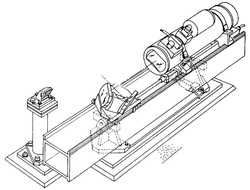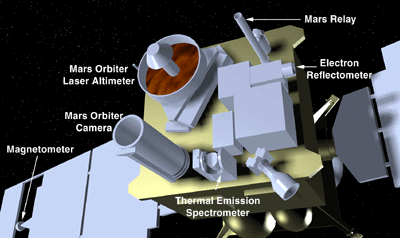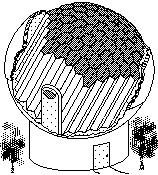
While still a student engineer, Dr. Kerr participated in the design and testing of an automatic surveying instrument. This instrument aligned the N. A. S. A. space vehicle guidance system seventeen seconds before launch. The lives of the Moon visitors depended on this. If they were only slightly off course after blasting off, they might miss the Moon and never return to the Earth.

His first professional work in 1964 showed N. A. S. A. how a laser can communicate between the earth and a space probe near Mars, at a distance of 100 million miles.

Dr. Kerr designed a laser instrument for measuring the height of volcanoes and the depth of valleys and rifts on Mars. The finished instrument, the Mars Global Surveyor, is still orbiting Mars. It was the first successful use of a laser beyond the orbit of the Moon. Thanks to the instrument our contour maps of Mars are better than the ones we have of the Earth. Another instrument like the first mapped the Asteroid Eros and reposes on it. A third instrument is aboard the MESSENGER mission to Mercury. The Japan Aerospace Exploration Agency put a similar instrument on the Hayabusa space probe, which recently returned rock samples from the Asteroid Itokawa.

N. A. S. A. awarded Dr. Kerr a prize for his design of a telescope (shown at right) adapted to receive laser communications from space probes going to Jupiter, Uranus, and Neptune, into the Kuiper Belt as far as 35 times the distance to Pluto, or beyond. When it is built, the telescope will be one of the largest of its kind in the world.
Academic Preparation
Ph. D. in physics 1971 from New York University
M. S. in physics 1968 from New York University
B. S. in electrical engineering 1964 from Columbia University
B. A. Magna cum laude 1964 Washington and Lee University
Postdoctoral studies: 77 semester hours in Spanish, Greek, Hebrew, and theology, Denver Seminary and Latin American Bible Seminary in San José, Costa Rica
Professional Employment
Universidad de Sevilla, Facultad de Física, Departamento de Electrónica y Electromagnetismo, Grupo de Microondas, invited professor, from November 1990 through October 1991.
Member of the Technical Staff, N. A. S. A., Jet Propulsion Laboratory, California Institute of Technology, 1986 to 1989.
Associate Professor of Physics, Azusa Pacific University, 1985 to 1987.
Profesor Asociado de Física, Universidad de Costa Rica, 1975 to 1982.
Associate Research Physicist, Perkin-Elmer Corporation, 50 Danbury Road, Wilton, Connecticut 06897, from 1964 to 1973
Languages
Artificial languages: FORTRAN, Basic, a smattering of assembly languages, DOS, Windows, Internet.
Natural languages: First language: English. Have full fluency in Spanish for conversation, teaching, reading, and writing. Can read articles in my specialty and speak as a tourist in French and German. Can read Biblical Greek and decipher Hebrew with a lexicon. Have some knowledge of Russian.
Publications
“An Integral Sunshade for Optical Reception Antennas,” Telecommunications and Data Acquisition Progress Report 42-95, 180-195 (15 Nov 1988)
“Shutters and Slats for the Integral Sunshade of an Optical Reception Antenna,” Telecommunications and Data Acquisition Progress Report 42-95, 196-201 (15 Nov 1988) – with C. W. DeVore
“An Integral Sunshade for an Optical Reception Antenna,” Optical Engineering 30(9), 1372‑1381 (1991)
“Architectural design of a ground-based deep-space optical reception antenna,” SPIE Proceedings 1059: Space Sensing, Communications, and Networking, Monte Ross and Richard J. Temkin, editors, 103-110 (1989). Presentation at the Society of Photo-Optical Instrumentation Engineers OE LASE `89 Conference in Los Angeles (17 Jan 1989). Augmented version in Optical Engineering 30(4), 446-451 (1991)
“A Near-Earth Optical Communications Terminal With a Corevolving Planetary Sunshield,” Telecommunications and Data Acquisition Progress Report 42-91, 133-140 (15 Nov 1987), also published in Journal of The British Interplanetary Society 42, 497‑500, (1989).
“Fraunhofer Filters to Reduce Solar Background for Optical Communications,” Telecommunications and Data Acquisition Progress Report 42-87, 48-55 (15 Nov 1986). Augmented version in Optical Engineering 28(9), 963-968 (1989)
“Strawman Optical Reception Development Antenna (SORDA),” Telecommunications and Data Acquisition Progress Report 42-93, 97-110 (15 May 1988)
“La propagación del haz gausiano en un medio dieléctrico con inhomogeneidad radial parabólica y cuártica,” (“Propagation of a Gaussian Beam in a dielectric medium with parabolic and quartic radial inhomogeneity”), Ciencia y Tecnología 3, 27-34, (1979).
“Estudio teórico del autoenfocado del rayo láser en vidrio por medio de la electrostricción,” (“Theoretical Study of Electrostrictive Laser Self-Focusing in Glass”), Ciencia y Tecnología 2, 219-226, (1978)
“The Alphaphone -- A Method for Measuring Thin-Film Absorption at Laser Wavelengths” Applied Optics 12, 2520-2527, (1973)
“Surface and Coating Absorption Measurement with an Alphaphone,” Laser-Induced Damage in Optical Materials: 1973, A. J. Glass and A. H. Guenther, editors (National Bureau of Standards, Boulder, Colorado, 1973) 189-193.
“Filamentary Tracks Formed in Transparent Optical Glass by Laser-Beam Self-Focusing. III. Filament Formation,” Physical Review A 6, 1162-1171, (1972).
“Track Formation in Optical Glass Caused by Electrostrictive Laser Beam Self-Focusing,” Dissertation Abstracts International 32, (1972)
“Electric Stress and Laser Surface Damage,” IEEE Journal of Quantum Electronics QE-8, 723-724, (1972)
“Electrostrictive Self-Focusing of Picosecond Laser Pulse Trains,” IEEE Journal of Quantum Electronics QE-7, 532-533, (1971)
“Filamentary Tracks Formed in Transparent Optical Glass by Laser-Beam Self-Focusing. II. Theoretical Analysis,” Physical Review A 4, 1195-1218, (1971).
“Electrostrictive Laser Beam Focusing in Glass and Small-Scale Track Formation,” Damage in Laser Materials: 1971, A. J. Glass and A. H. Guenther, editors, (National Bureau of Standards, Boulder, Colorado, 1971), 61-75.
“Transient and Steady-State Electrostrictive Laser Beam Trapping,” IEEE Journal of Quantum Electronics QE-6, 616-621, (1970)
“A Simple Algorithm for Fast Real-Time Generation of Pseudorandom Poisson Integers with Rapidly Varying Means,” Proceedings of the IEEE 57, 2088 (1969), with R. E. Hufnagel
“Laser-Beam Self-Focusing and Glass Damage Caused by Electrostrictively Driven Acoustic Waves,” Special Technical Publication 469, American Society for Testing and Materials (Philadelphia, 1969), 23-42
“The Laser Illuminated Absorptivity Spectrophone: A Method for Measurement of Weak Absorptivity in Gases at Laser Wavelengths,” Applied Optics 7, 915-921 (1968), with J. G. Atwood.
Patents and Prizes
“Method and Apparatus for Measuring Thin Film Absorption at Laser Wavelengths,” U. S. Patent 3,811,782, 21 May 1974
“Gas Analyzer,” U. S. Patent 3,727,050, 10 April 1973
“Laser-Excited Spectrophone,” U. S. Patent 3,659,452, 2 May 1972, with J. G. Atwood
“Microphone,” U. S. Patent 3,433,959, 18 March 1969, with J. G. Atwood
Certificate of Recognition and N. A. S. A. Prize for “An Integral Sunshade for an Optical Reception Antenna,” 25 August 1989—Described as a “Compact Sunshade for Telescope Antenna,” in N. A. S. A. Tech Briefs, 14(6), June 1990, pp. 58 and 60
“Laser Altimeter for Mars Sample Return Mission,” Jet Propulsion Laboratory Interoffice Memorandum 331-86.6-270, 18 November 1986, and “Laser Pushbroom Altimeter for Mars Sample Return,” Jet Propulsion Laboratory Interoffice Memorandum 331-86.6-279, 5 January 1987. These two memos were preliminary designs for the Mars Orbiter Laser Altimeter, part of the Mars Global Surveyor, in Mars orbit since 15 September 1997. Another version reposes on the Asteroid Eros, and a third is measuring Mercury.
Ph. D. in physics 1971 from New York University
M. S. in physics 1968 from New York University
B. S. in electrical engineering 1964 from Columbia University
B. A. Magna cum laude 1964 Washington and Lee University
Postdoctoral studies: 77 semester hours in Spanish, Greek, Hebrew, and theology, Denver Seminary and Latin American Bible Seminary in San José, Costa Rica
Professional Employment
Universidad de Sevilla, Facultad de Física, Departamento de Electrónica y Electromagnetismo, Grupo de Microondas, invited professor, from November 1990 through October 1991.
Member of the Technical Staff, N. A. S. A., Jet Propulsion Laboratory, California Institute of Technology, 1986 to 1989.
Associate Professor of Physics, Azusa Pacific University, 1985 to 1987.
Profesor Asociado de Física, Universidad de Costa Rica, 1975 to 1982.
Associate Research Physicist, Perkin-Elmer Corporation, 50 Danbury Road, Wilton, Connecticut 06897, from 1964 to 1973
Languages
Artificial languages: FORTRAN, Basic, a smattering of assembly languages, DOS, Windows, Internet.
Natural languages: First language: English. Have full fluency in Spanish for conversation, teaching, reading, and writing. Can read articles in my specialty and speak as a tourist in French and German. Can read Biblical Greek and decipher Hebrew with a lexicon. Have some knowledge of Russian.
Publications
“An Integral Sunshade for Optical Reception Antennas,” Telecommunications and Data Acquisition Progress Report 42-95, 180-195 (15 Nov 1988)
“Shutters and Slats for the Integral Sunshade of an Optical Reception Antenna,” Telecommunications and Data Acquisition Progress Report 42-95, 196-201 (15 Nov 1988) – with C. W. DeVore
“An Integral Sunshade for an Optical Reception Antenna,” Optical Engineering 30(9), 1372‑1381 (1991)
“Architectural design of a ground-based deep-space optical reception antenna,” SPIE Proceedings 1059: Space Sensing, Communications, and Networking, Monte Ross and Richard J. Temkin, editors, 103-110 (1989). Presentation at the Society of Photo-Optical Instrumentation Engineers OE LASE `89 Conference in Los Angeles (17 Jan 1989). Augmented version in Optical Engineering 30(4), 446-451 (1991)
“A Near-Earth Optical Communications Terminal With a Corevolving Planetary Sunshield,” Telecommunications and Data Acquisition Progress Report 42-91, 133-140 (15 Nov 1987), also published in Journal of The British Interplanetary Society 42, 497‑500, (1989).
“Fraunhofer Filters to Reduce Solar Background for Optical Communications,” Telecommunications and Data Acquisition Progress Report 42-87, 48-55 (15 Nov 1986). Augmented version in Optical Engineering 28(9), 963-968 (1989)
“Strawman Optical Reception Development Antenna (SORDA),” Telecommunications and Data Acquisition Progress Report 42-93, 97-110 (15 May 1988)
“La propagación del haz gausiano en un medio dieléctrico con inhomogeneidad radial parabólica y cuártica,” (“Propagation of a Gaussian Beam in a dielectric medium with parabolic and quartic radial inhomogeneity”), Ciencia y Tecnología 3, 27-34, (1979).
“Estudio teórico del autoenfocado del rayo láser en vidrio por medio de la electrostricción,” (“Theoretical Study of Electrostrictive Laser Self-Focusing in Glass”), Ciencia y Tecnología 2, 219-226, (1978)
“The Alphaphone -- A Method for Measuring Thin-Film Absorption at Laser Wavelengths” Applied Optics 12, 2520-2527, (1973)
“Surface and Coating Absorption Measurement with an Alphaphone,” Laser-Induced Damage in Optical Materials: 1973, A. J. Glass and A. H. Guenther, editors (National Bureau of Standards, Boulder, Colorado, 1973) 189-193.
“Filamentary Tracks Formed in Transparent Optical Glass by Laser-Beam Self-Focusing. III. Filament Formation,” Physical Review A 6, 1162-1171, (1972).
“Track Formation in Optical Glass Caused by Electrostrictive Laser Beam Self-Focusing,” Dissertation Abstracts International 32, (1972)
“Electric Stress and Laser Surface Damage,” IEEE Journal of Quantum Electronics QE-8, 723-724, (1972)
“Electrostrictive Self-Focusing of Picosecond Laser Pulse Trains,” IEEE Journal of Quantum Electronics QE-7, 532-533, (1971)
“Filamentary Tracks Formed in Transparent Optical Glass by Laser-Beam Self-Focusing. II. Theoretical Analysis,” Physical Review A 4, 1195-1218, (1971).
“Electrostrictive Laser Beam Focusing in Glass and Small-Scale Track Formation,” Damage in Laser Materials: 1971, A. J. Glass and A. H. Guenther, editors, (National Bureau of Standards, Boulder, Colorado, 1971), 61-75.
“Transient and Steady-State Electrostrictive Laser Beam Trapping,” IEEE Journal of Quantum Electronics QE-6, 616-621, (1970)
“A Simple Algorithm for Fast Real-Time Generation of Pseudorandom Poisson Integers with Rapidly Varying Means,” Proceedings of the IEEE 57, 2088 (1969), with R. E. Hufnagel
“Laser-Beam Self-Focusing and Glass Damage Caused by Electrostrictively Driven Acoustic Waves,” Special Technical Publication 469, American Society for Testing and Materials (Philadelphia, 1969), 23-42
“The Laser Illuminated Absorptivity Spectrophone: A Method for Measurement of Weak Absorptivity in Gases at Laser Wavelengths,” Applied Optics 7, 915-921 (1968), with J. G. Atwood.
Patents and Prizes
“Method and Apparatus for Measuring Thin Film Absorption at Laser Wavelengths,” U. S. Patent 3,811,782, 21 May 1974
“Gas Analyzer,” U. S. Patent 3,727,050, 10 April 1973
“Laser-Excited Spectrophone,” U. S. Patent 3,659,452, 2 May 1972, with J. G. Atwood
“Microphone,” U. S. Patent 3,433,959, 18 March 1969, with J. G. Atwood
Certificate of Recognition and N. A. S. A. Prize for “An Integral Sunshade for an Optical Reception Antenna,” 25 August 1989—Described as a “Compact Sunshade for Telescope Antenna,” in N. A. S. A. Tech Briefs, 14(6), June 1990, pp. 58 and 60
“Laser Altimeter for Mars Sample Return Mission,” Jet Propulsion Laboratory Interoffice Memorandum 331-86.6-270, 18 November 1986, and “Laser Pushbroom Altimeter for Mars Sample Return,” Jet Propulsion Laboratory Interoffice Memorandum 331-86.6-279, 5 January 1987. These two memos were preliminary designs for the Mars Orbiter Laser Altimeter, part of the Mars Global Surveyor, in Mars orbit since 15 September 1997. Another version reposes on the Asteroid Eros, and a third is measuring Mercury.